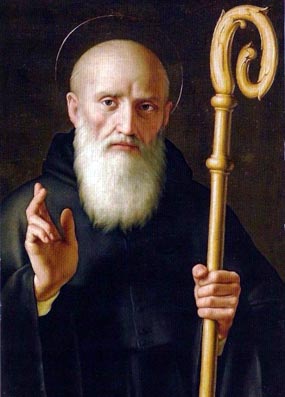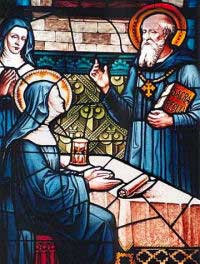
11 July
St. Benedict of Nursia (480-547)
Founder of Western Monasticism
Born: 480, Norcia (Umbria, Italy)
Died: 21 March 547 at Monte Cassino, Italy
Canonized: 1220
Major Shrine: Monte Cassino Abbey, with his burial
Saint-Benoît-sur-Loire, near Orléans, France
Sacro Speco, at Subiaco, Italy
Patron: Against poison, Against witchcraft, Cavers, Civil engineers, Coppersmiths, Dying people, Erysipelas, Europe, Farmers, Fever, Gall stones, Inflammatory diseases, Italian architects, Kidney disease, Monks, Nettle rash, Schoolchildren, Servants who have broken their master’s belongings, Speleologists, Spelunkers, Temptations
St. Benedict was born at Nursia in Umbria in about 480 and was sent to Rome to be educated, but soon left the world to live a solitary life at Subiaco. After living in a cave in the mountains for two years as a hermit, he had acquired such a reputation that disciples came in numbers to join him and important Roman families entrusted him with the education of their children. He organized a form of monastic life in twelve small monasteries. Under his guidance, as abbot, the monks vowed to seek God and devoted themselves to work and prayer. A few years later St. Benedict left the district of Subiaco to found the great abbey of Monte Cassino on the heights of Campania. There he wrote his Rule in which are wonderfully combined the Roman genius and the monastic wisdom of the Christian East. St. Benedict died in 547.
COLLECT PRAYER
O God, who made the Abbot Saint Benedict an outstanding master in the school of divine service, grant, we pray, that, putting nothing before love of you, we may hasten with a loving heart in the way of your commands. Through our Lord Jesus Christ, your Son, who lives and reigns with you in the unity of the Holy Spirit, God, for ever and ever.
Things to Do:
- Purchase a copy of
- Try St. Benedict: Hero of the Hills and The Holy Twins for the children.
- Monasteries kept bees to provide honey for sweetening and mead made from fermented honey — wax was in great demand for candles. Honey and mead were used to make herbal remedies more palatable! Although it is not officially marked in the Roman Ritual,, there is a remote connection with St. Benedict and the Blessing of Bees. Read Address on Bees by Pius XII.
- After Benedict had been living as a hermit for several years a religious community came to him after the death of their abbot and asked Benedict to take over. Some of the monks didn’t like this plan and the rigor of his rule and attempted to kill him with poisoned bread and wine. When St. Benedict made the sign of the Cross over the cup of wine and the bread, the cup holding the wine shattered (some versions say it spilled) and some versions indicate a raven carried off the bread. This website gives an explanation of the St. Benedict Medal and the meaning of the symbols on it which includes the poisoned cup and the raven. And for more about the medal read The Medal of St. Benedict by Fr. Bernardine Patterson OSB.
- From Catholic Culture’s Library:
- Rule of St. Benedict,
- Fulgens Radiatur (On St. Benedict) Pius XII,
- Order of St. Benedict,
- The Holy Father’s Message of July 7, 1999 sent to the Abbot of Subiaco for the celebration of the 1,500th anniversary of the foundation of St. Benedict’s first monastery there.
St. Benedict
![]() Born in Nursia, Italy, he was educated in Rome, was repelled by the vices of the city and in about 500 fled to Enfide, thirty miles away. He decided to live the life of a hermit and settled at mountainous Subiaco, where he lived in a cave for three years, fed by a monk named Romanus.
Born in Nursia, Italy, he was educated in Rome, was repelled by the vices of the city and in about 500 fled to Enfide, thirty miles away. He decided to live the life of a hermit and settled at mountainous Subiaco, where he lived in a cave for three years, fed by a monk named Romanus.
Despite Benedict’s desire for solitude, his holiness and austerities became known and he was asked to be their abbot by a community of monks at Vicovaro. He accepted, but when the monks resisted his strict rule and tried to poison him, he returned to Subiaco and soon attracted great numbers of disciples. He organized them into twelve monasteries under individual priors he appointed, made manual work part of the program, and soon Subiaco became a center of spirituality and learning. He left suddenly, reportedly because of the efforts of a neighboring priest, Florentius, to undermine his work, and in about 525 settled at Monte Cassino.
He destroyed a pagan temple to Apollo on its crest, brought the people of the neighboring area back to Christianity, and in about 530 began to build the monastery that was to be the birthplace of Western monasticism. Soon disciples again flocked to him as his reputation for holiness, wisdom, and miracles spread far and wide. He organized the monks into a single monastic community and wrote his famous rule prescribing common sense, a life of moderate asceticism, prayer, study, and work, and community life under one superior. It stressed obedience, stability, zeal, and had the Divine Office as the center of monastic life; it was to affect spiritual and monastic life in the West for centuries to come.
While ruling his monks (most of whom, including Benedict, were not ordained), he counseled rulers and Popes, ministered to the poor and destitute about him, and tried to repair the ravages of the Lombard Totila’s invasion. He died at Monte Cassino on March 21.
Excerpted from the Dictionary of Saints, John J. Delaney
 Born in Norcia about 480, Benedict’s first studies were in Rome but, disappointed with city life, he retired to Subiaco, where he stayed for about three years in a cave—the famous sacro speco—dedicating himself wholly to God. In Subiaco, making use of the ruins of a cyclopean villa of the emperor Nero, he built some monasteries, together with his first disciples, giving life to a fraternal community founded on the primacy of the love of Christ, in which prayer and work were alternated harmoniously in praise of God.
Born in Norcia about 480, Benedict’s first studies were in Rome but, disappointed with city life, he retired to Subiaco, where he stayed for about three years in a cave—the famous sacro speco—dedicating himself wholly to God. In Subiaco, making use of the ruins of a cyclopean villa of the emperor Nero, he built some monasteries, together with his first disciples, giving life to a fraternal community founded on the primacy of the love of Christ, in which prayer and work were alternated harmoniously in praise of God.
Years later, he completed this project in Monte Cassino, and put it in writing in his Rule, the only work of his that has come down to us. Amid the ashes of the Roman Empire, Benedict, seeking first of all the kingdom of God, sowed, perhaps even without realizing it, the seed of a new civilization which would develop, integrating Christian values with classical heritage, on one hand, and the Germanic and Slav cultures on the other.
There is a particular aspect of his spirituality, which today I would particularly like to underline. Benedict did not found a monastic institution oriented primarily to the evangelization of barbarian peoples, as other great missionary monks of the time, but indicated to his followers that the fundamental, and even more, the sole objective of existence is the search for God: “Quaerere Deum.”
He knew, however, that when the believer enters into a profound relationship with God he cannot be content with living in a mediocre way, with a minimalist ethic and superficial religiosity. In this light, one understands better the expression that Benedict took from St. Cyprian and that is summarized in his Rule (IV, 21)—the monks’ program of life: Nihil amori Christi praeponere. Prefer nothing to the love of Christ.
Holiness consists in this valid proposal for every Christian that has become a true pastoral imperative in our time, in which one perceives the need to anchor life and history in solid spiritual references.
Excerpted from Benedict XVI’s Angelus address of July 10, 2005
Source: Catholic Culture